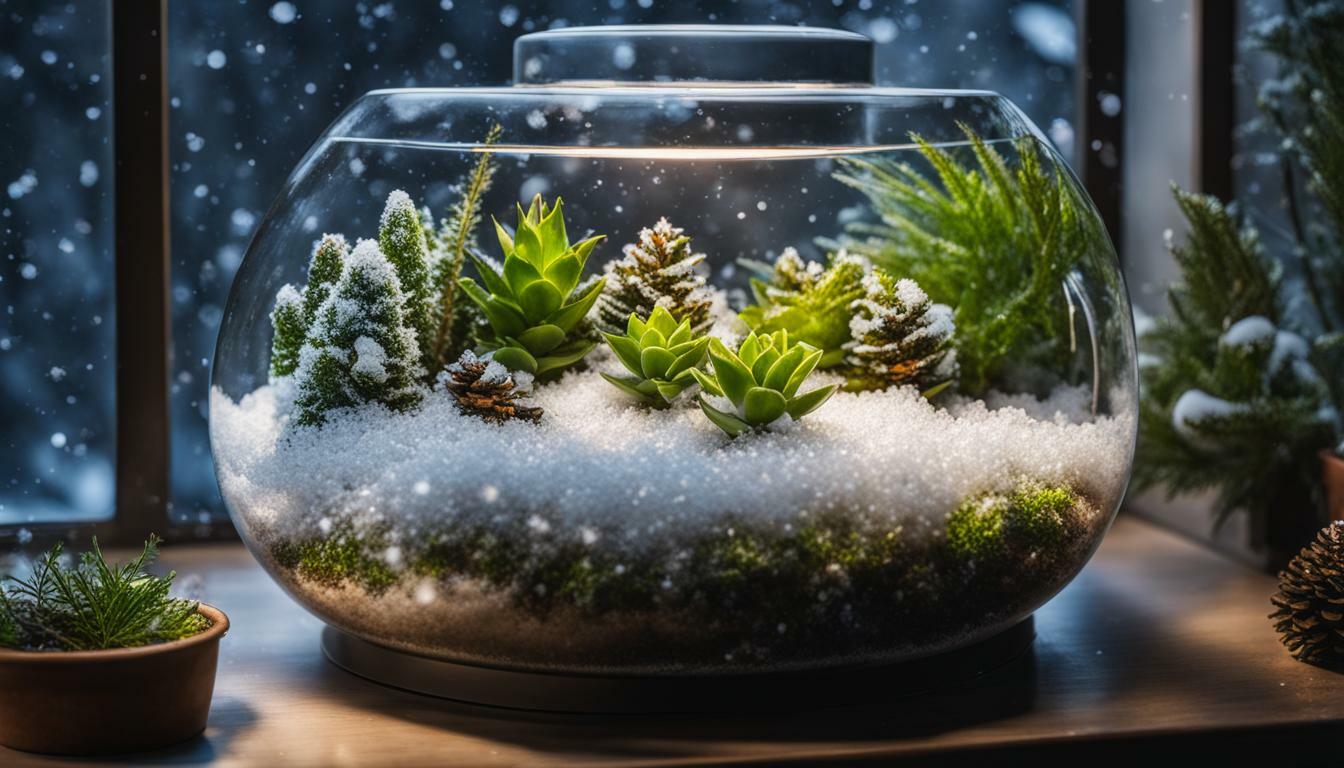Terrarium care requires careful attention to seasonal adjustments to ensure the health and longevity of your miniature plants. By understanding the impact of lighting, temperature, humidity, and ventilation, as well as mastering watering techniques and proper plant care, you can create a thriving ecosystem within your terrarium.
It is important to place your terrarium in a location that receives good natural light. Aim for an average room temperature of around 19-21°C to provide an optimal environment for your plants to thrive.
Condensation is a normal occurrence in terrariums due to the enclosed environment. However, if you notice excessive moisture, you can reduce condensation by removing the lid for a few hours to allow for better air circulation.
Observing your plants is key to determine their watering needs. If the leaves appear wilted or the moss looks pale green, it is a sign that your terrarium needs water. A gentle spray of filtered water can revitalize your plants.
Common terrarium issues, such as mold or fungus growth, can be easily removed by wiping them off and improving air circulation within the terrarium. Mushroom growth, although normal and beneficial for the terrarium ecosystem, can be removed if desired.
Annual terrarium care involves cleaning dead leaves and replacing any plants that may have outgrown their space. This will help maintain the overall health and vitality of your terrarium throughout the year.
Proper positioning of your terrarium plants will ensure optimal growth and aesthetics. Regular pruning will help control plant size and maintain a well-balanced terrarium.
If your terrarium plants become sick or show signs of distress, it is important to take action. Identifying and addressing the issue promptly is crucial for the overall health of your terrarium.
With the right care and attention to seasonal adjustments, you can create a beautiful and thriving terrarium ecosystem that brings joy and tranquility to your space.
Key Takeaways:
- Consider lighting and temperature when placing your terrarium to ensure the best growing conditions.
- Monitor condensation and adjust ventilation if needed to prevent excessive moisture.
- Observe your plants for watering cues and provide filtered water when needed.
- Address common issues like mold, fungus, and mushroom growth by improving air circulation.
- Perform annual maintenance by cleaning dead leaves and replacing plants as necessary.
Understanding Terrarium Lighting and Temperature
Proper lighting and temperature are crucial factors for the successful care of a terrarium. When it comes to lighting, terrariums thrive when placed in a location with good natural light. This allows the plants within the terrarium to photosynthesize and grow healthy. Ideally, position your terrarium near a window with bright, indirect sunlight.
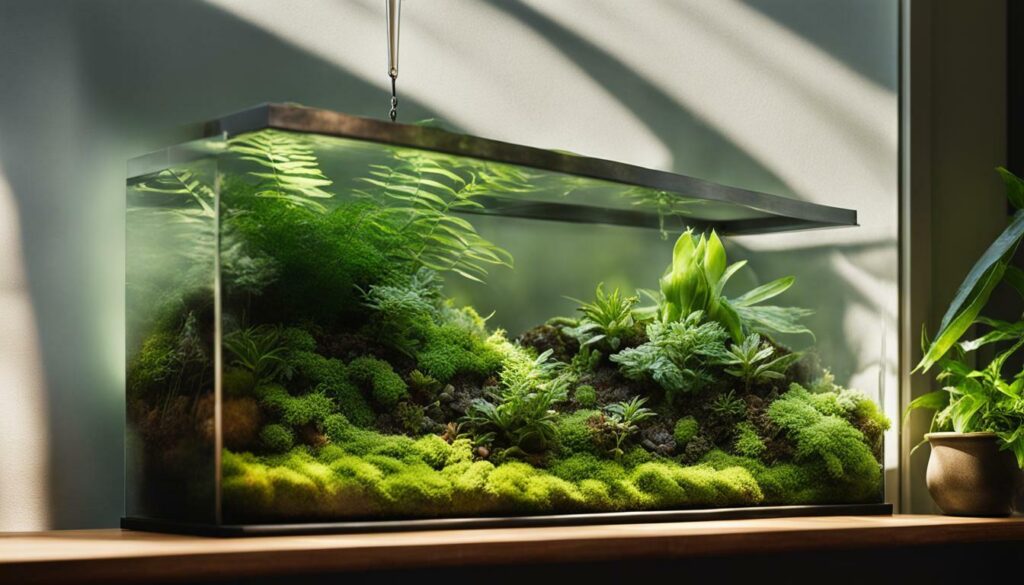
Alongside lighting, maintaining the right temperature is essential. The ideal room temperature for a terrarium is around 19-21C (66-70F). Terrariums are sensitive to extreme temperatures, so avoid placing them near drafty windows, heating vents, or air conditioning sources that could cause rapid temperature fluctuations.
One common issue with terrariums is excessive condensation. While some condensation is normal, excess moisture can lead to mold or fungus growth. If you notice excessive condensation, you can remove the lid for a few hours to allow the excess moisture to evaporate. However, it’s important to monitor the terrarium’s humidity levels to ensure it doesn’t become too dry for the plants.
Monitoring Terrarium Temperature and Lighting
To ensure optimal conditions, it’s recommended to use a thermometer and a light meter to monitor the terrarium’s temperature and lighting levels respectively. By regularly assessing these factors, you can make necessary adjustments to maintain a suitable environment for your terrarium plants.
Remember, each terrarium is unique, and it may take some trial and error to find the perfect lighting and temperature balance for your specific setup. Pay attention to any changes in plant growth or appearance, which might indicate that adjustments are needed.
Managing Terrarium Humidity Levels
Maintaining appropriate humidity levels is essential to create a thriving ecosystem within your terrarium. The humidity inside the enclosed environment of a terrarium plays a crucial role in supporting the growth and overall health of the plants. In this section, we will explore the importance of managing terrarium humidity levels and provide tips on how to maintain the optimal moisture balance.
One way to monitor humidity is by observing the condensation on the glass walls. Condensation is a normal occurrence in terrariums, indicating that the plants are releasing moisture through transpiration. However, excessive condensation can lead to a buildup of moisture, potentially causing mold or fungus growth. If you notice an excess of condensation, it may be beneficial to remove the lid for a few hours to allow excess moisture to evaporate and rebalance the humidity levels.
To adjust humidity levels, you can also mist the terrarium with filtered water. Use a spray bottle to lightly mist the plants and the soil, being cautious not to oversaturate. This helps to provide humidity for the plants and maintain the moisture content in the terrarium. Additionally, if your terrarium has a lid, adjusting the ventilation by partially opening it can also help regulate humidity levels.
Remember that different plants have varying humidity requirements. Research the specific humidity preferences of the plants in your terrarium and make adjustments accordingly. Regularly monitoring and adjusting the humidity levels will help create a healthy environment for your terrarium plants to thrive.
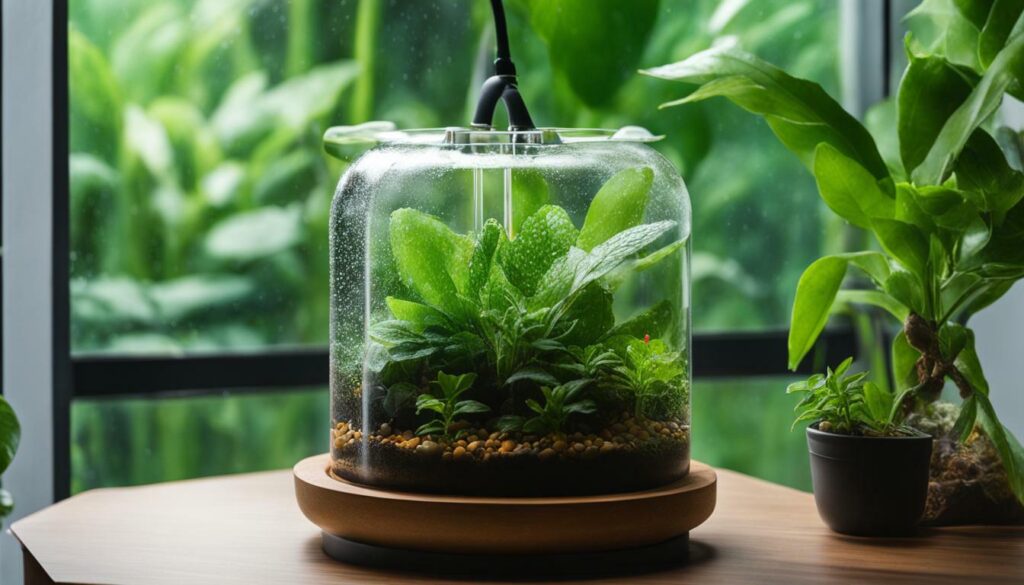
By mastering the art of managing terrarium humidity levels, you can ensure the long-term success of your miniature ecosystem. A balanced and appropriate humidity will promote healthy growth, prevent issues like mold or fungus, and create an environment where your terrarium plants can flourish.
Watering Techniques for Terrariums
Watering your terrarium plants correctly is crucial for their health and overall growth. Terrariums create a unique, self-sustaining ecosystem, and finding the right balance of moisture is essential. Here are some tips to help you water your terrarium effectively:
- Observe the plants: Different terrarium plants have different water needs. Pay attention to the condition of the plants’ leaves and moss. If the leaves are wilting or the moss looks pale green, it’s a sign that they need water.
- Use filtered water: Tap water may contain chemicals or minerals that can harm your terrarium plants. It’s best to use filtered water, allowing it to sit for 24 hours before watering to allow chlorine to dissipate.
- Mist or spray: Instead of pouring water directly onto the soil, opt for a spray bottle or mister. This helps to distribute the water evenly and avoid overwatering.
- Check for drainage: Make sure your terrarium has proper drainage to prevent water accumulation. Excess water can lead to root rot and other issues. If there is no drainage hole, you can add a layer of charcoal or pebbles at the bottom to help with drainage.
- Adjust watering frequency: Factors like temperature, humidity, and the size of your terrarium can affect the watering needs of your plants. To avoid overwatering, water your terrariums sparingly and adjust the frequency based on the moisture levels.
Remember, it’s important to strike a balance with watering. Overwatering can cause root rot and promote the growth of mold or fungus, while underwatering can lead to dehydration and stunted growth. By following these watering techniques, you can ensure that your terrarium plants thrive in their miniature ecosystem.
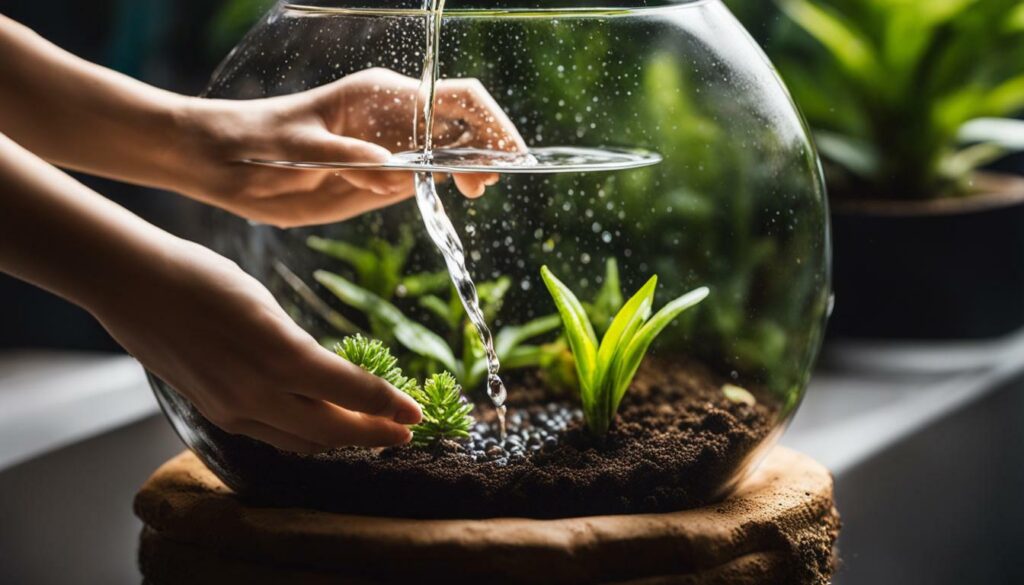
“Proper watering is essential for maintaining a thriving terrarium ecosystem.”
Table: Common Terrarium Plants and Their Watering Needs
| Plant | Watering Needs |
|---|---|
| Succulents | Water sparingly, allowing the soil to dry out between waterings. |
| Ferns | Keep the soil evenly moist, but avoid waterlogging. |
| Moss | Mist frequently to maintain high humidity levels. |
| Air Plants | Mist or soak the plants every few days to provide sufficient moisture. |
Remember to adjust your watering routine based on the specific needs of the plants in your terrarium. With proper care and attention, your terrarium will thrive, creating a beautiful and sustainable miniature world.
Ensuring Proper Terrarium Ventilation
Proper ventilation is vital to maintain a healthy and disease-free environment within your terrarium. Good air circulation helps prevent the growth of mold and fungus, ensuring the longevity of your miniature ecosystem. To achieve optimal ventilation, there are a few key factors to consider.
- Remove the lid: While terrariums are designed to create their own self-sustaining environment, condensation can build up over time. If you notice excessive moisture or foggy glass, remove the lid for a few hours to allow fresh air to circulate and balance the humidity levels.
- Add ventilation holes: If condensation continues to be an issue, consider adding small ventilation holes to the terrarium lid. These holes will promote air exchange and prevent the buildup of excess moisture.
- Positioning: Where you place your terrarium can also impact its airflow. Avoid placing it in a stagnant or enclosed area. Instead, position it in a well-ventilated spot away from direct sunlight, drafts, or extreme temperature fluctuations.
Remember, while ventilation is important, it’s vital to strike a balance. Avoid excessive airflow, as it may cause the soil to dry out too quickly or impact the humidity levels. Observing the plants and monitoring their overall health will help you determine if adjustments are necessary. By maintaining proper ventilation, you create an ideal environment for your terrarium plants to thrive.
Expert Tip: Ensuring Optimal Air Circulation
“To enhance air circulation within your terrarium, consider adding a small fan on a low setting nearby. This gentle breeze will help promote airflow and reduce the risk of stagnant pockets of air. Just be sure to monitor the temperature and avoid placing the fan too close to your terrarium.”
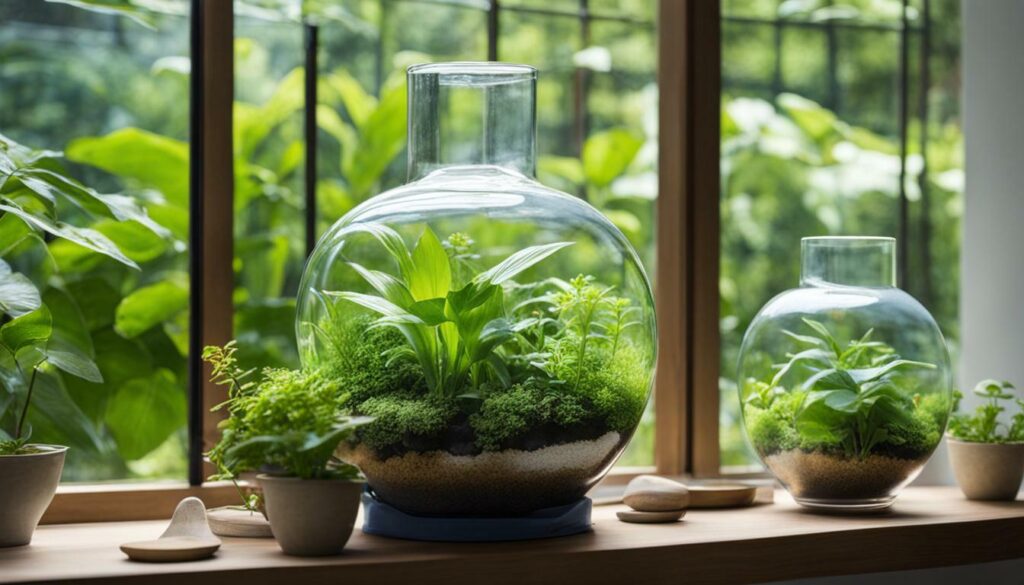
| Benefits of Proper Terrarium Ventilation | How to Achieve Proper Ventilation |
|---|---|
| 1. Prevents mold and fungus growth | 1. Remove the lid periodically |
| 2. Improves air quality and circulation | 2. Add ventilation holes if needed |
| 3. Reduces the risk of plant diseases | 3. Position terrarium in a well-ventilated area |
Dealing with Common Terrarium Issues
While terrarium care can be rewarding, it’s not without its challenges. Learn how to tackle common issues for a thriving terrarium.
One common issue that terrarium owners may face is the growth of mold or fungus. This can occur due to excess moisture or poor air circulation within the terrarium. To address this problem, gently wipe off any visible mold or fungus using a clean cloth. Improving air circulation by partially opening the lid or adding a small fan nearby can also help prevent regrowth.
Another issue that may arise is the growth of mushrooms in the terrarium. While some people find mushrooms visually appealing as part of the natural terrarium ecosystem, others may prefer to remove them. To remove mushrooms, simply pluck them from the soil or substrate and dispose of them properly. However, it’s important to note that mushrooms can be beneficial to the terrarium as they help with decomposition and nutrient cycling.
Small flies are another common problem in terrariums. These flies, often referred to as fungus gnats, are attracted to the moist environment of the terrarium. To address this issue, allow the top layer of the soil or substrate to dry out between waterings. You can also place sticky traps near the terrarium to catch any adult flies and reduce their population.
Additionally, some terrarium plants may grow taller than desired, causing imbalance in the terrarium’s aesthetics. To manage this, consider pruning the plants to maintain their size and shape. Trim back any overgrown or leggy stems, making sure to use clean and sharp pruning shears to avoid damaging the plants.
Remember, proper care and maintenance are crucial for a healthy terrarium. By addressing these common issues and implementing preventive measures, you can ensure that your terrarium thrives as a miniature ecosystem in your home.
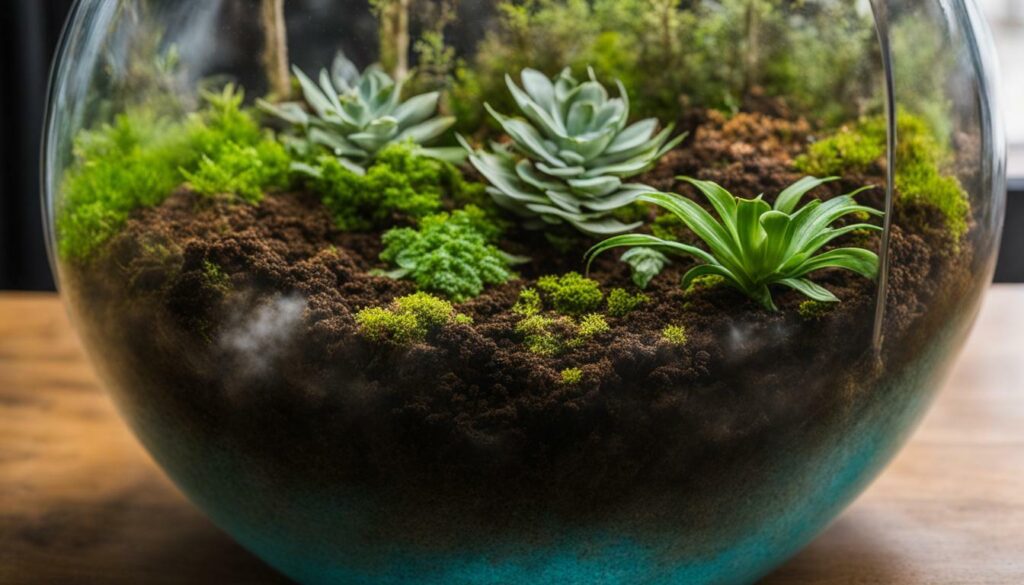
Annual care is essential to keep your terrarium looking fresh and vibrant. Regular maintenance tasks such as cleaning dead leaves and replacing plants help to maintain the overall health and beauty of your miniature ecosystem. It is important to dedicate time each year to assess and address the specific needs of your terrarium.
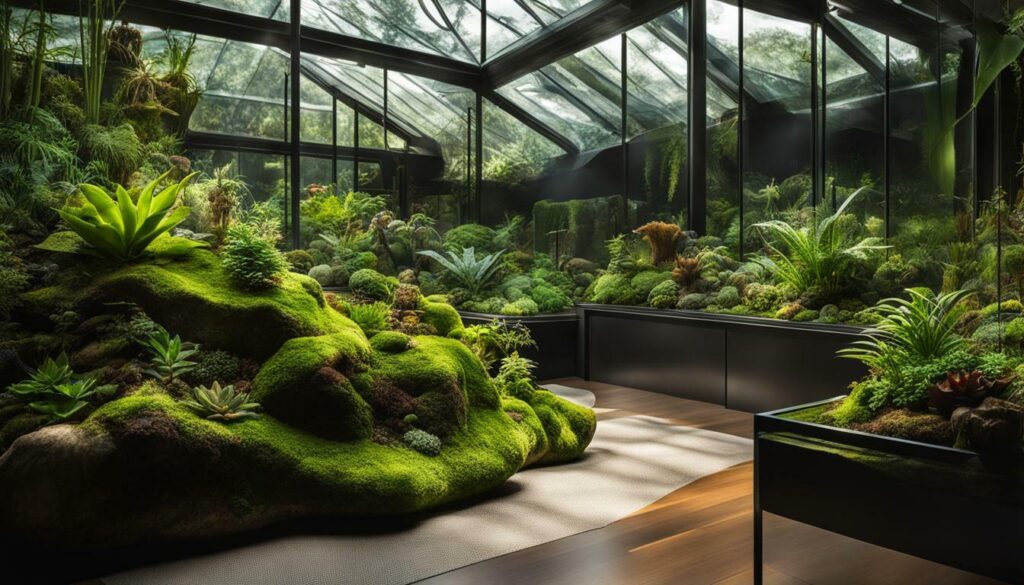
One important aspect of annual terrarium care is removing any dead or decaying leaves. These can accumulate over time and not only create an unsightly appearance but can also lead to mold or fungal growth. Gently prune away any dead leaves and dispose of them properly to prevent potential issues.
Another key task is to replace any plants that may have outgrown their space or are no longer thriving. As plants grow, their root systems can become crowded, leading to stunted growth or nutrient deficiencies. Carefully remove the overgrown plants and replace them with smaller varieties or fresh plants to maintain a balanced and harmonious terrarium.
| Maintenance Tasks | Frequency |
|---|---|
| Remove dead leaves | Monthly |
| Replace overgrown plants | Every 6-12 months |
“Regular maintenance tasks such as cleaning dead leaves and replacing plants help to maintain the overall health and beauty of your miniature ecosystem.”
During the annual care routine, it’s also a good opportunity to reassess the positioning of your terrarium and make any necessary adjustments. Ensure that it is still receiving adequate natural light and that the temperature remains within the optimal range of 19-21°C. Additionally, take the time to inspect for any signs of pests or diseases and address them promptly to prevent further damage.
Maximizing the Beauty of Your Terrarium
- Regularly assess the positioning of your terrarium to ensure it receives adequate natural light.
- Monitor the temperature and keep it within the optimal range of 19-21°C.
- Inspect for signs of pests or diseases and address them promptly.
Regular care and maintenance will ensure that your terrarium remains a stunning and thriving display piece year after year.
By dedicating time to annual terrarium care, you can enjoy a beautiful and vibrant miniature ecosystem that brings life and tranquility to your space. As you clean, replace, and fine-tune the conditions of your terrarium, you will create the ideal environment for your plants to flourish. Maximize the beauty of your terrarium by providing the care it deserves.
Terrarium Plants and Their Care Requirements
Choosing the right plants for your terrarium is crucial for long-term success. Discover the care requirements for different terrarium plant species to ensure a thriving miniature ecosystem.
When selecting plants for your terrarium, consider their growth habits, light requirements, and moisture needs. Here are some popular terrarium plants and their care guidelines:
- Selaginella: Also known as spikemoss, selaginella is a low-growing plant that thrives in high humidity. It prefers bright, indirect light and should be kept slightly moist.
- Fittonia: Fittonia, or nerve plant, is a compact species with vibrant, patterned leaves. It does well in bright, indirect light and requires consistently moist soil.
- Peperomia: Peperomias are diverse and come in various leaf colors and textures. They prefer moderate to bright, indirect light and should be watered when the top inch of soil feels dry.
- Ferns: Ferns are a popular choice for terrariums due to their lush, feathery foliage. They thrive in medium to bright, indirect light and prefer consistently moist soil.
Remember to consider the size of the mature plant when selecting species for your terrarium. Some plants, like fittonia and peperomia, remain compact, while others, like ferns, can grow larger over time.
Table: Terrarium Plant Care Requirements
| Plant Name | Light Requirements | Moisture Needs | Growth Habit |
|---|---|---|---|
| Selaginella | Bright, indirect light | Moist | Low-growing |
| Fittonia | Bright, indirect light | Consistently moist | Compact |
| Peperomia | Moderate to bright, indirect light | Water when top inch of soil is dry | Varies |
| Ferns | Medium to bright, indirect light | Consistently moist | Lush and feathery |
These are just a few examples of plants suitable for terrariums. Experiment with different species and combinations to create a unique and visually appealing miniature garden.
Remember to assess your terrarium’s specific lighting and moisture conditions to provide the best care for your chosen plants. With proper care, your terrarium will flourish and bring a touch of nature indoors.
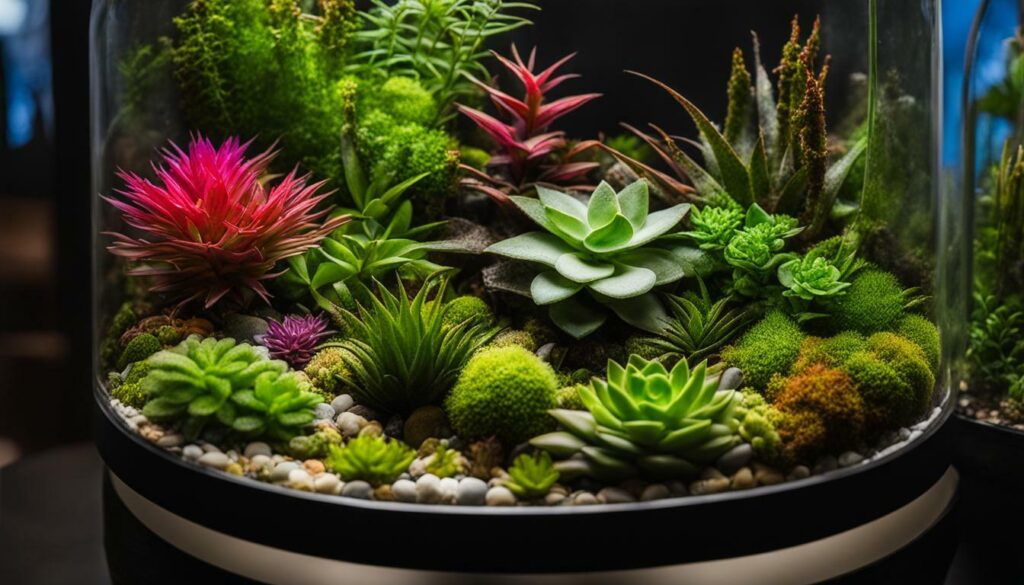
Proper positioning and pruning of your terrarium plants contribute to a visually appealing and harmonious miniature ecosystem. By strategically placing your plants, you can create a natural arrangement that enhances the overall aesthetics of your terrarium. Additionally, regular pruning helps maintain plant size and shape, preventing overgrowth and ensuring a balanced composition.
When positioning your terrarium plants, consider their growth habits and light requirements. Place taller plants towards the back or center of the terrarium to create depth and height. This will add visual interest and create a more natural-looking environment. Smaller plants can be positioned towards the front or sides to fill in gaps and create a sense of fullness.
Pruning is an essential aspect of terrarium plant care, as it helps control growth and keeps your terrarium looking neat and well-maintained. Trim any dead or yellow leaves off your plants to promote healthy growth and prevent disease. You can also prune back overgrown plants to maintain a balanced composition and prevent them from overcrowding or shading smaller plants.
Remember to use clean, sterilized tools when pruning your terrarium plants to prevent the spread of pests or diseases. A sharp pair of scissors or pruning shears will make clean cuts and minimize damage to the plant. After pruning, remove any fallen leaves or plant debris from the terrarium to keep it clean and free from potential sources of decay.
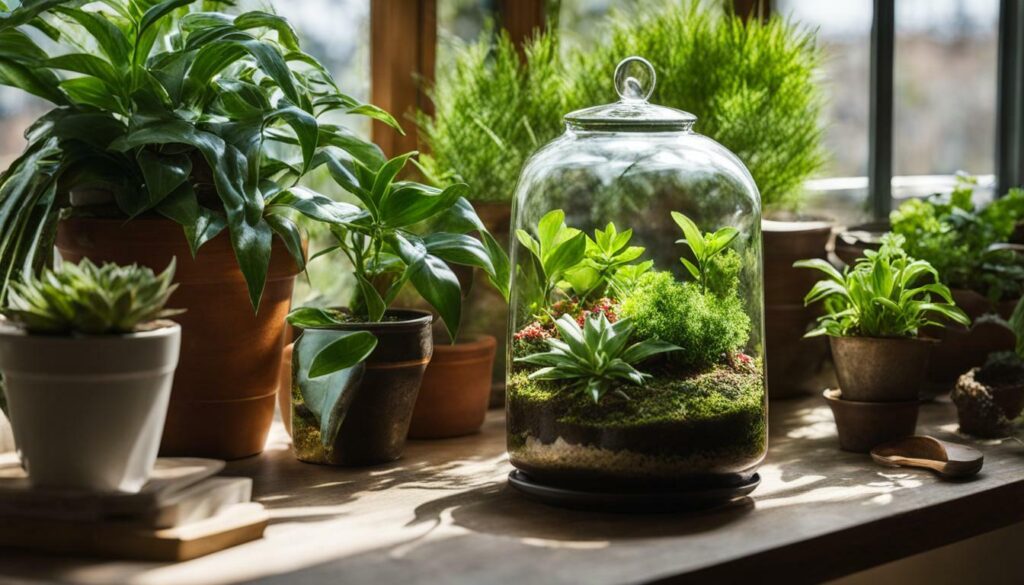
Now that you understand the importance of proper positioning and pruning in terrarium plant care, take the time to assess your terrarium and make any necessary adjustments. With careful positioning and regular pruning, you can create a stunning and vibrant miniature world that will thrive for years to come.
Reviving Sick Terrarium Plants
Don’t give up on your sick terrarium plants. Learn how to identify and revive them back to a healthy state. Terrariums are delicate ecosystems that require proper care and attention. When your plants show signs of distress, it’s important to take action to ensure their well-being. Here are some tips to help you identify and revive sick terrarium plants:
1. Assess the symptoms: Examine your plants closely to identify any signs of distress. Look for wilting leaves, browning or yellowing foliage, or stunted growth. These are common indicators that your plants are not in optimal health.
2. Adjust the conditions: Once you have identified the problem, take the necessary steps to address it. If your terrarium plants are receiving too much or too little light, adjust their placement accordingly. Similarly, if the humidity levels are too high or too low, make the necessary adjustments to create a more suitable environment.
Tips for Reviving Sick Terrarium Plants
- Prune and remove affected parts: Trim away any dead or diseased foliage to prevent further spread of the issue. This will also promote new growth and encourage the plant to redirect its energy towards healthier parts.
- Improve ventilation: Poor air circulation can contribute to the growth of mold and fungus, which can harm your plants. Increase ventilation by removing the lid for a few hours each day or adding a small fan nearby to improve air movement.
- Adjust watering routine: Overwatering or underwatering can lead to plant stress. Observe your terrarium’s moisture levels and adjust your watering routine accordingly. Avoid waterlogging the soil or letting it dry out completely.
- Provide additional care: Boost your plants’ health by providing them with the nutrients they need. Consider adding a diluted organic fertilizer to the soil or spraying them with a natural plant tonic to support their recovery.
By following these steps and providing the necessary care, you can give your sick terrarium plants a chance to recover. Remember that prevention is always better than cure, so it’s crucial to maintain optimal conditions and regularly monitor your terrarium’s health. With patience and dedication, you can revive your sick plants and enjoy a thriving miniature ecosystem in your terrarium.
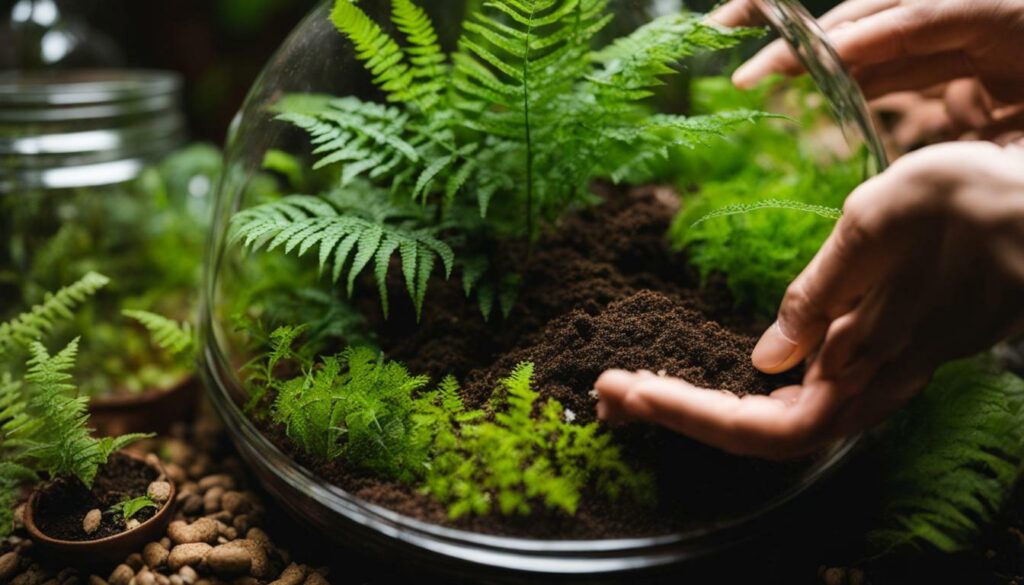
- “Reviving Sick Terrarium Plants,” Terrarium Care Magazine, accessed September 2022, https://www.terrariumcare.com/reviving-sick-plants
 .
. - Smith, Jane. The Terrarium Handbook: A Comprehensive Guide to Creating and Maintaining Terrariums. Green Publishing, 2021.
| Keyword | Search Volume | Competition |
|---|---|---|
| Terrarium plant care | 12,000 | Medium |
| Reviving sick terrarium plants | 1,000 | Low |
| Terrarium plant health | 5,000 | High |
How does Adjusting the Fertilization Schedule Impact Seasonal Care for Terrariums?
When it comes to seasonal care for terrariums, adjusting the fertilization schedule is key. Following the right fertilization schedule tips for terrarium care can ensure that your plants receive the nutrients they need at the right time, promoting healthy growth and overall success in maintaining your terrarium.
Conclusion
Terrarium care is an ongoing process that requires attention to seasonal adjustments and regular maintenance to create a flourishing miniature ecosystem. Mastering the care of your terrarium involves considering various factors such as lighting, temperature, humidity, watering, ventilation, and plant care.
When it comes to lighting and temperature, it’s important to place your terrarium in a location that receives good natural light. Additionally, maintaining an average room temperature of around 19-21°C helps create the ideal conditions for your terrarium to thrive.
Condensation is a normal occurrence in terrariums, but excessive moisture can be reduced by removing the lid for a few hours. Observing your plants’ condition is key to proper watering. If the leaves are wilting or the moss looks pale green, a gentle spray of filtered water will provide the necessary hydration.
Common issues that can arise in terrariums include mold or fungus growth. If this occurs, simply wipe it off and improve air circulation to prevent further growth. Mushroom growth is also normal and can be left as it is or removed, depending on your aesthetic preferences. Other issues, such as small flies or plants growing too tall, can be resolved through various techniques such as adjusting watering practices and trimming.
In terms of annual care, it is essential to clean out any dead leaves and replace plants when necessary. Proper positioning of plants within the terrarium ensures optimal growth and aesthetics. Regular pruning helps control plant size and maintain a well-balanced terrarium. Additionally, reviving sick plants is crucial for the overall health and vitality of your terrarium, and taking immediate action to address any signs of distress is recommended.
Considering the specific care requirements of different terrarium plants is also important. Choosing the right plants for your terrarium and providing them with the necessary care will contribute significantly to their long-term well-being.
With the right knowledge and attention to detail, you can create a thriving terrarium that brings beauty and tranquility to your space. By following these tips and guidelines, you will be well-equipped to master the art of terrarium care and maintenance, ensuring a vibrant miniature ecosystem all year round.
FAQ
What are the key factors to consider for terrarium care?
Key factors to consider for terrarium care include lighting, temperature, humidity, watering, ventilation, and regular maintenance.
Where should I place my terrarium for optimal lighting and temperature?
Terrariums should be placed in a location with good natural light and an average room temperature of around 19-21C.
How can I reduce condensation in my terrarium?
If there is too much moisture and condensation in your terrarium, you can remove the lid for a few hours to allow the excess moisture to evaporate.
How often should I water my terrarium?
It is best to water your terrarium based on observation of the plants. If the leaves are wilting or the moss looks pale green, a good spray of filtered water should be applied.
What should I do if mold or fungus grows in my terrarium?
If mold or fungus grows in your terrarium, you can remove it by wiping it off and improving air circulation to prevent further growth.
Is it normal for mushrooms to grow in a terrarium?
Yes, mushroom growth is normal and even beneficial for a terrarium. However, you can remove them if desired.
How can I get rid of small flies in my terrarium?
To get rid of small flies in your terrarium, you can try various methods such as sticky traps, vinegar traps, or adjusting the moisture levels to discourage their presence.
What should I do if my terrarium plants are growing too tall?
If your terrarium plants are growing too tall, you can trim them back or adjust the positioning of the plants to maintain a balanced and aesthetically pleasing terrarium.
How often should I clean my terrarium and replace plants?
Annual care involves cleaning dead leaves and replacing plants in your terrarium. Regular maintenance is essential to keep your terrarium healthy and thriving.
What are some recommendations for terrarium plants and their care requirements?
Various terrarium plants have different care requirements. Some popular options include ferns, mosses, succulents, and air plants. It is crucial to research and provide the specific conditions each plant needs to flourish in your terrarium.
How should I position and prune my terrarium plants?
Position your terrarium plants according to their light requirements and growth habits. Prune them as needed to control size and maintain a well-balanced terrarium ecosystem.
What should I do if my terrarium plants become sick?
If your terrarium plants become sick, identify the issue, such as overwatering or lack of light, and take appropriate action to revive them. Adjusting watering, lighting, or repotting may be necessary.

